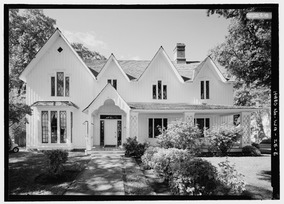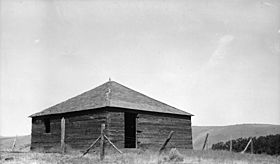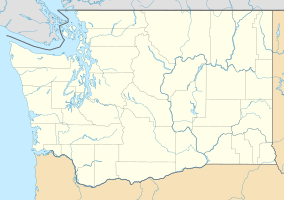Fort Simcoe facts for kids
Quick facts for kids Fort Simcoe Historical State Park |
|
|---|---|

Commandant's House
|
|
| Location | Yakima, Washington, United States |
| Area | 200 acres (81 ha) |
| Elevation | 1,401 ft (427 m) |
| Established | 1856-1859 |
| Operator | Washington State Parks and Recreation Commission |
| Website | Fort Simcoe State Park |
|
Fort Simcoe State Park
|
|

Fort Simcoe blockhouse, ca. 1930s (HABS archives)
|
|
| Location | Yakima County, SW of Yakima on SR-220 |
| Nearest city | Yakima, Washington |
| Built | 1856 |
| Architect | Robert Seldon Garnett; Louis Scholl |
| Architectural style | Gothic Revival |
| NRHP reference No. | 74001994 |
| Added to NRHP | June 27, 1974 |
Fort Simcoe was a United States Army fort built in south-central Washington Territory. Its main purpose was to house soldiers who watched over local Native American tribes. Today, the fort and its remaining buildings are protected as Fort Simcoe Historical State Park. You can find it about eight miles (13 km) west of White Swan, Washington, in the lower parts of the Cascade Mountains.
Contents
History of Fort Simcoe
Early Days as a School Site
Before 1850, the area where Fort Simcoe now stands was used as a school. Native American children from different tribes across Washington were brought here. At this school, children were taught American customs and the English language. This meant they were often not allowed to practice their own traditions. This was a very difficult time for many Native American families and their children.
Building the Fort
The fort itself was built in the late 1850s. It was placed in an old oak grove that had natural springs. A future Civil War general named Robert S. Garnett oversaw its construction. The fort was only used by the army for about three years. Later, in 1956, the site became a state park.
Why Fort Simcoe Was Built
Fort Simcoe was built in the middle of the Yakima Valley. This area was important to the Yakama Tribe for fishing. The fort's location allowed soldiers to keep an eye on the tribe and anyone visiting them. This period was a challenging time in the relationship between the U.S. government and Native American tribes.
The U.S. government wanted to bring 14 different tribes together and teach them American culture. They were taught about famous Americans and given Christian or American names. This was part of a plan to change Native American ways of life.
Fort Design and Location Importance
An architect named Louis Scholl designed Fort Simcoe. It was similar to another fort called Fort Dalles. Both forts had strong blockhouses at their corners. However, they did not have a stockade (a fence of tall posts). Instead, the barracks (soldiers' living quarters) formed the fort's outer shape.
The location of Fort Simcoe was also important for travel. It helped the army create a road system. This system connected California with the Washington Territory. This shows how important the fort's location was for government plans and movement. In 1922, the U.S. government moved the Indian agency from Fort Simcoe to Toppenish. This move brought back strong feelings of past relocations for the original tribes.
Park and Museum Today
Visiting Fort Simcoe Historical State Park
Fort Simcoe Historical State Park is a 200-acre (0.81 km2) park. It is located on the Yakama Indian Reservation. The park is a day-use heritage park. This means you can visit during the day to learn about history. The park helps tell the story of army life in the mid-1800s. It also shares information about the lives of local Native Americans.
Buildings and Exhibits
Five of the original buildings from the fort are still standing today:
- The commander's house
- Three captain's houses
- One blockhouse
Other buildings have been rebuilt to look like the originals. The houses are filled with furniture from that time period. This helps visitors imagine what life was like back then. In 1974, the park was added to the National Register of Historic Places.
What You Can See
The park's interpretive center is open to the public. You can also visit the original commander's house and two officer's buildings. These are open from April through September, Wednesday through Sunday. The original blockhouse and other rebuilt fort buildings are not open for visitors to go inside. The park often holds special events. These include re-enactments and living history events.


